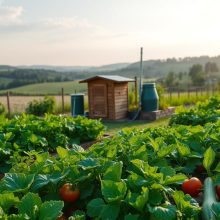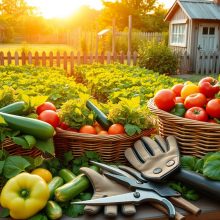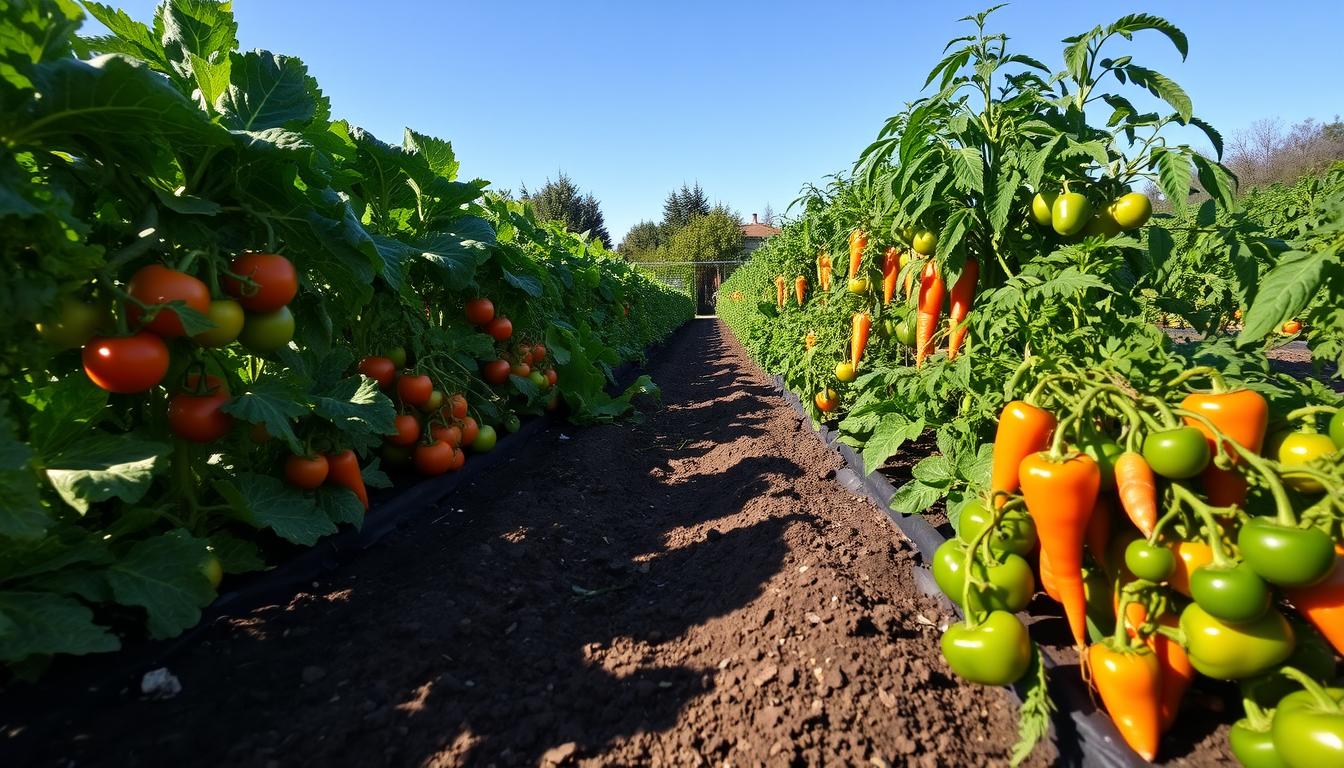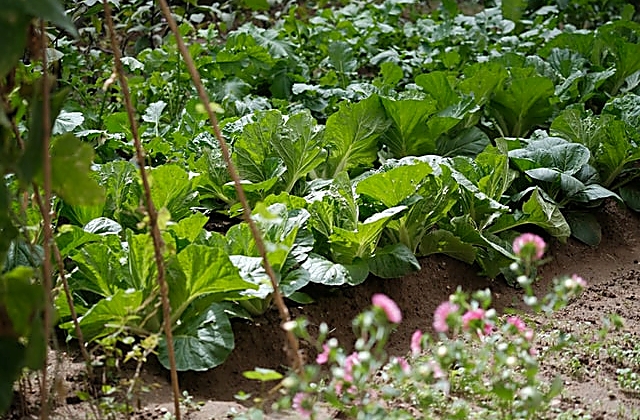Vegetable Garden Tips: Secrets to a Bountiful Harvest
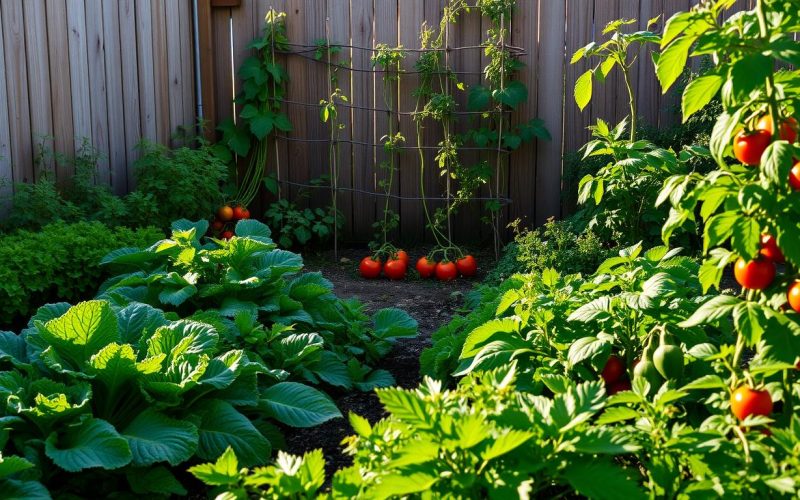
Growing a thriving vegetable garden needs careful planning and hard work. With the right tips, even beginners can become skilled gardeners. They can grow plenty of fresh veggies in their own backyard.
Every gardener wants to fill their baskets with fresh, healthy veggies. To do this, you must learn the basics of gardening. This includes preparing the soil and choosing the right crops.
Gardening is both an art and a science. By using proven methods and learning from mistakes, gardeners can grow tasty, nutritious veggies. These veggies not only feed our bodies but also our souls.
Key Takeaways
- Proper planning is essential for a successful vegetable garden
- Understanding your local climate and soil conditions is crucial
- Select vegetables that thrive in your specific growing environment
- Consistent care and maintenance are key to a bountiful harvest
- Learn from each gardening season to improve future results
Choose the Right Location for Your Garden
Starting a beginner’s guide to vegetable gardening means picking the perfect spot. The right location is key to your garden’s success. It affects plant health, growth, and your harvest.
When starting a vegetable garden, choosing the location is crucial. Most gardens need careful planning for the best growing conditions.
Assessing Sunlight Exposure
Sunlight is vital for a successful vegetable garden. Most veggies need 6-8 hours of direct sunlight each day. Here are some tips for sunlight:
- Watch your garden spot during the day
- See where the sun moves and find full-sun areas
- Stay away from too much shade from buildings or trees
Evaluating Soil Quality
Good soil is essential for a thriving garden. Experts suggest soil testing to see what you have:
- Do a basic soil pH test
- Check the nutrient levels
- See how well it drains
Considering Accessibility
Your garden should be easy to get to and maintain. Pick a spot that’s simple to water, weed, and harvest. Being close to water and your home makes gardening more fun and easy.
Selecting the Best Vegetables for Your Climate
Starting a successful vegetable garden begins with knowing your local growing conditions. Picking the right vegetables is key to a productive garden. Every climate has its own challenges and chances for growing great vegetables.
Cool-Season vs. Warm-Season Crops
Vegetables fall into two main groups based on their temperature needs:
- Cool-Season Crops: Do well in temperatures between 40-70°F
- Lettuce
- Spinach
- Broccoli
- Peas
- Warm-Season Crops: Grow best in temperatures between 65-95°F
- Tomatoes
- Peppers
- Cucumbers
- Squash
Local Varieties for Optimal Growth
Choosing vegetables that grow well in your area boosts your garden’s success. Local seed stores and agricultural offices can suggest the best varieties for your climate. These plants usually have better disease resistance and produce more.
Companion Planting Benefits
Companion planting is a smart strategy in organic gardening. It involves placing plants together to improve pest control, nutrient uptake, and space use. For example, tomatoes and basil or beans and corn are great pairs.
Preparing Your Soil for Planting
Starting a vegetable garden right means getting your soil ready. Knowing your soil’s base is key. Healthy soil gives your plants the nutrients and support they need to grow well.
Testing Soil pH Levels
Soil pH is very important for growing veggies. Most plants like a slightly acidic soil, with a pH between 6.0 and 7.0. You can test your soil pH at home with:
- DIY pH testing kits from garden centers
- Digital pH meters
- Professional soil testing services
Adding Organic Matter
Adding organic matter to your soil can really help your garden. Compost, aged manure, and leaf mold can make poor soil better. They improve soil structure, help with drainage, and give plants the nutrients they need.
Tilling Techniques
Good tilling breaks up hard soil and mixes in organic matter. Here are some tips for tilling your vegetable garden:
- Till when the soil is a bit moist, not too wet
- Don’t over-till to avoid damaging the soil structure
- Work organic matter into the top 6-8 inches of soil
By following these tips, you’ll build a solid base for a garden that’s full of life and fresh veggies all season long.
Deciding on Garden Layout
Designing the right garden layout is key for successful vegetable gardening. Understanding your space and choosing a layout that maximizes productivity is important. When starting a vegetable garden, the right design can greatly impact your success.
Traditional Rows vs. Raised Beds
Gardeners have two main layout options:
- Traditional Row Gardening
- Needs more ground space
- Easier for big equipment access
- Lower initial setup cost
- Raised Bed Gardening
- Better soil control
- Improved drainage
- Less soil compaction
- More ergonomic for planting
Square Foot Gardening
Square foot gardening is a smart way to use small spaces. It divides garden areas into small, manageable sections. This method lets you plant different crops in each section, making your garden dense and efficient.
Vertical Gardening Options
Vertical gardening is great for those with little ground space. It uses trellises, wall systems, and hanging planters to grow vegetables up. Ideal crops for vertical gardens include:
- Tomatoes
- Cucumbers
- Pole beans
- Peas
The right garden layout depends on your space, physical abilities, and gardening goals. Each method has its own benefits for a productive vegetable garden.
Developing a Planting Schedule
Creating a planting schedule is key for a successful vegetable garden. Experts say planning is vital for a healthy and productive garden. Planting at the right time can greatly boost your harvest.
Timing for Planting Seeds
Knowing when to plant seeds is essential. Each vegetable needs the right conditions to grow well. Gardeners should track local weather and planting times carefully.
- Check local frost dates for your specific region
- Use soil temperature as a key indicator for planting
- Consider microclimates within your garden space
Using a Garden Calendar
A garden calendar makes planting precise. Experts suggest using calendars to mark important dates. This helps gardeners stay on track all season.
- Mark last and first frost dates
- Record seed starting times
- Note expected harvest periods
Rotating Crops for Soil Health
Crop rotation keeps soil healthy and pest-free. By changing where plants grow each season, gardeners improve soil and reduce disease.
- Avoid planting similar crops in the same location year after year
- Group vegetables by plant families
- Create a multi-year rotation plan
Watering Techniques for Vegetables
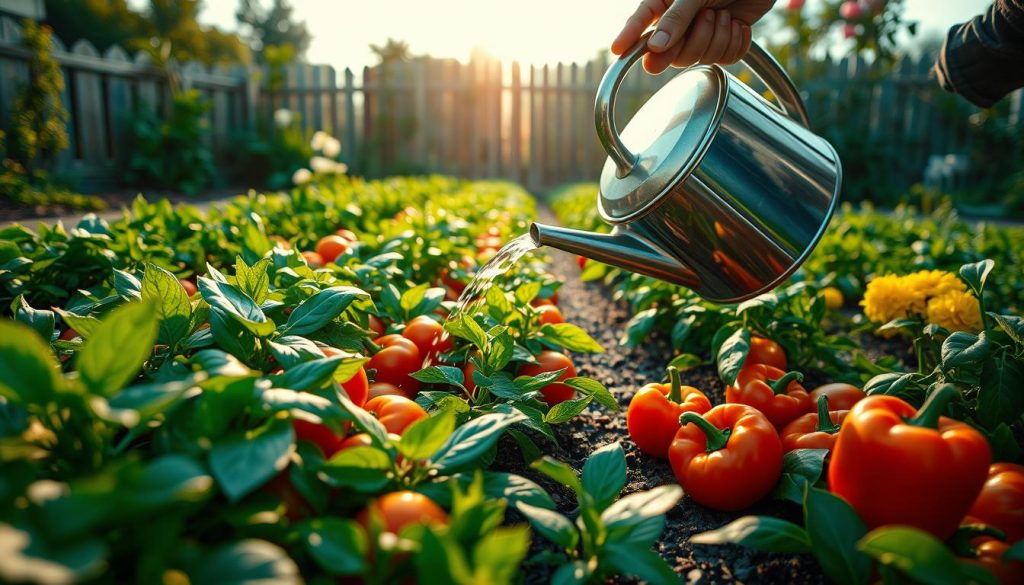
Learning how to water your vegetable garden is key. Water is essential for plant growth and nutrient uptake. Knowing the best watering methods can greatly improve your garden’s health.
Importance of Consistent Moisture
Keeping your plants moist is vital. To have a healthy garden, water consistently. This keeps the soil moist but not too wet. Each vegetable needs a different amount of water, so it’s important to know what each one needs.
Drip Irrigation vs. Hand Watering
Choosing the right way to water is important. Here are some options:
- Drip Irrigation:
- Water goes straight to the roots
- Less water is wasted
- Leaves stay dry
- Hand Watering:
- Allows you to check on plants closely
- Flexibility in watering times
- Great for smaller gardens
Signs of Over or Under-Watering
It’s important to know when your plants need more or less water. Look out for these signs:
- Under-watering symptoms:
- Leaves start to wilt
- Leaf edges become dry and crispy
- Plants grow slowly
- Over-watering indicators:
- Leaves turn yellow
- Plants don’t grow well
- Fungi start to grow
By following these tips, you can water your garden in a way that promotes healthy growth and a good harvest.
Effective Pest Management Strategies
Keeping pests out of your vegetable garden is key to success. Organic gardening tips focus on prevention and natural ways to control pests. This keeps your garden healthy and pest-free.
Natural Pest Control Methods
Using natural pest control needs a smart plan. Here are some organic methods to try:
- Create physical barriers using row covers
- Plant companion crops that naturally repel insects
- Use homemade organic sprays with neem oil or garlic
- Practice crop rotation to disrupt pest lifecycles
Beneficial Insects to Attract
Some insects help control pests in your garden. Attract these beneficial bugs to keep pests in check:
- Ladybugs that consume aphids
- Praying mantises targeting multiple pest species
- Lacewings which eat soft-bodied insects
- Ground beetles that consume slug eggs
Monitoring for Common Pests
Regularly checking your garden is vital for early pest detection. Look for signs of damage on plants weekly. Watch for leaf discoloration, holes, or unusual growth. Quick action helps protect your garden’s health.
Fertilizing Your Vegetable Garden
Successful vegetable gardening starts with knowing about plant nutrition. It’s key to use the right tips for growing vegetables. Fertilizing is crucial for healthy, productive plants and a good harvest.
Good nutrition turns a regular garden into a great one. To garden well, you need to know how plants get and use nutrients.
Understanding NPK Ratios
Fertilizers have three numbers for nitrogen (N), phosphorus (P), and potassium (K). These nutrients help plants in different ways:
- Nitrogen helps with leafy green growth
- Phosphorus aids in root growth and flower production
- Potassium boosts overall health and fights diseases
Organic vs. Synthetic Fertilizers
There are organic and synthetic fertilizers, each with its own benefits. Organic fertilizers give nutrients slowly and make soil better. Synthetic fertilizers give nutrients quickly.
Timing Your Fertilization
Fertilizing at the right time is important for plant growth. Use balanced fertilizers at these stages:
- Before planting to get the soil ready
- During the early growth stages
- When plants start producing vegetables
By following these tips, gardeners can make their plants strong and get great harvests.
The Role of Mulching
Mulching is a key technique in vegetable garden tips. It can change how you garden. This method protects and feeds your plants from the start.
Benefits of Mulching
Gardeners know mulching’s great benefits. It helps plants grow well and boosts garden output:
- Retains soil moisture
- Suppresses weed growth
- Regulates soil temperature
- Prevents soil erosion
- Adds nutrients as organic mulches decompose
Types of Mulch to Consider
Choosing the right mulch is important. Each type has its own benefits:
- Organic mulches:
- Straw
- Leaves
- Wood chips
- Grass clippings
- Inorganic mulches:
- Plastic sheeting
- Landscape fabric
- Stones or gravel
Applying Mulch Correctly
Applying mulch right is crucial. Use a 2-3 inch layer around plants. Keep it a few inches from stems to avoid disease. Organic mulches are best for vegetable gardens because they improve soil over time.
By following these tips, you’ll make a better environment for your plants. This will help your garden grow healthier and more productive.
Harvesting Your Crops
Learning to harvest is key to a successful garden. Experts say timing and technique are crucial. The right way can greatly improve your harvest’s quality and amount.
Identifying the Perfect Harvest Time
Figuring out when to pick your veggies takes patience and knowledge. Knowing each vegetable’s signs of ripeness is important:
- Tomatoes should be fully colored and slightly soft to the touch
- Peppers reach peak flavor when they develop full color
- Zucchini are best picked when 6-8 inches long
- Leafy greens can be harvested as continuous crops
Safe Harvesting Techniques
Experts advise gentle handling to protect your crops and plants. Use clean, sharp tools to avoid damage. When picking, cut or twist carefully to not stress the plant.
Storing Fresh Vegetables
Proper storage keeps your harvest fresh longer. Each vegetable has its own needs:
- Root vegetables thrive in cool, dark spaces
- Tomatoes should be stored at room temperature
- Leafy greens need refrigeration with slight moisture
- Herbs can be dried or kept in water like cut flowers
By following these tips, gardeners can get the most from their harvest. Enjoy fresh, healthy food from your garden.
Dealing with Weather Challenges
Vegetable gardening needs you to be tough and flexible, mainly when the weather is unpredictable. Gardeners who succeed know how to shield their crops from harsh weather. These tips will guide you through various environmental hurdles during the growing season.
Protecting Plants from Frost
Frost can destroy your vegetable garden quickly. To keep your garden safe, try these strategies:
- Use row covers to create a protective barrier
- Deploy portable cold frames for sensitive plants
- Water plants before an expected frost to help retain heat
- Place mulch around plant bases for insulation
Strategies for Excessive Heat
Summer heat can stress your plants and lower yields. Here are some tips to fight high temperatures:
- Install shade cloth during peak afternoon hours
- Mulch heavily to retain soil moisture
- Water deeply and early in the morning
- Choose heat-tolerant vegetable varieties
Managing Heavy Rainfall
Too much rain can cause root rot and soil compaction. To protect your crops, follow these tips:
- Create raised beds for improved drainage
- Use organic matter to enhance soil structure
- Install drainage channels around garden areas
- Select plants with good water tolerance
By understanding and preparing for different weather challenges, gardeners can protect their vegetable gardens. This ensures a rich harvest, no matter the weather.
Importance of Garden Maintenance
Keeping a vegetable garden healthy needs regular care. Good garden strategies mean keeping plants in top shape. Gardeners who care for their garden well will see better crops and garden health.
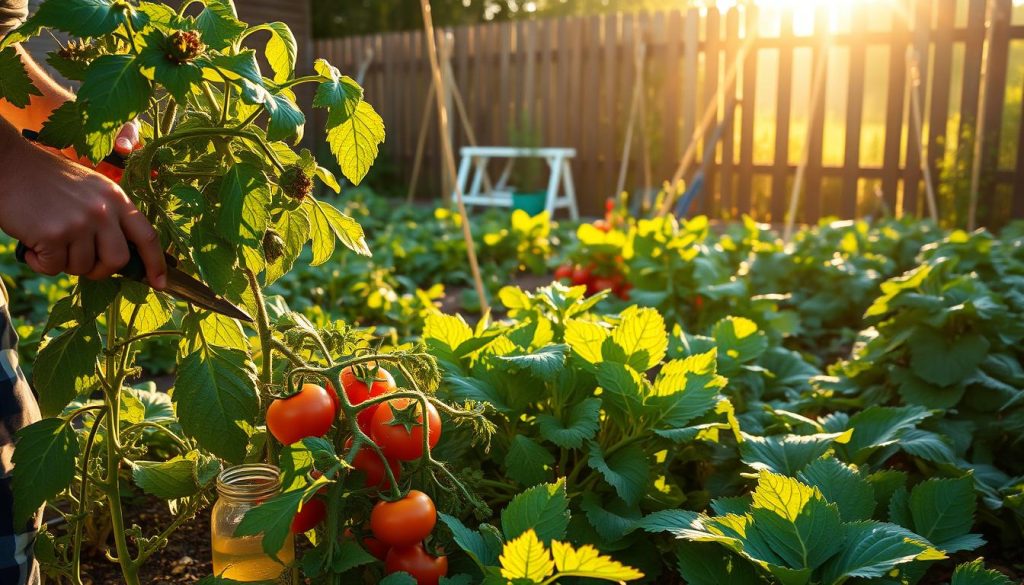
Starting with the basics of garden care is key. A well-kept garden avoids many problems before they start.
Regular Weeding Practices
Weeding is key to garden care. Weeds take water, nutrients, and sunlight from your veggies. Here’s how to weed effectively:
- Remove weeds when the soil is moist
- Use hand tools for precise removal
- Mulch to stop weeds from growing
- Stick to a weekly weeding routine
Pruning Techniques for Healthy Growth
Pruning helps veggies grow strong and produce more. Each veggie needs its own pruning method:
- Take out dead or sick plant parts
- Trim tomato suckers for better air
- Prune pepper plants for bushier growth
- Thin out crowded seedlings
Seasonal Maintenance Tasks
Gardens change with the seasons, needing special care. Gardeners should plan a maintenance schedule. This includes soil prep, pest checks, and crop rotation for ongoing health.
Learning From Failure
Every vegetable garden has its own story of growth and challenges. Learning from setbacks is key for success. Experts say failure helps you become a better gardener.
Analyzing Crop Failures
Successful gardening is like being a detective. When crops don’t do well, find out why. Common problems include:
- Nutrient deficiencies in soil
- Pest infestations
- Inappropriate watering techniques
- Unsuitable climate conditions
Adjusting Your Strategies
Being adaptable is important for gardeners. After finding the problem, plan how to fix it next time. You might:
- Improve soil quality
- Use natural pest control
- Choose stronger plant varieties
- Change planting times
Keeping a Gardening Journal
Keeping a journal is very helpful. It tracks your progress and notes important details. Write about the plants, growing conditions, harvests, and any problems.
Every failed crop is a chance to learn and improve. Enjoy the journey of gardening with curiosity and determination.
Exploring Organic Gardening Practices
Organic vegetable gardening is a way to grow food that’s good for you and the planet. More people are choosing natural gardening methods. These methods help keep our ecosystems healthy and improve our well-being.
Benefits of Going Organic
Switching to organic gardening can make your garden a chemical-free haven. Here are some key tips:
- Eliminating synthetic pesticides and fertilizers
- Promoting soil biodiversity
- Reducing environmental contamination
- Producing more nutrient-dense vegetables
Certifications to Look For
Knowing about organic certifications is important. The USDA Organic certification is a trusted sign of sustainable gardening. Here are some certifications to look for:
- USDA Organic Standard
- Certified Naturally Grown
- California Certified Organic Farmers (CCOF)
Resources for Organic Gardening
There are many ways to learn about organic gardening. Local offices, online courses, and gardening groups are great resources. They offer tips on growing food naturally.
By following organic gardening tips, you can make your garden healthier. It will also help the environment and improve your health.
Community Resources for Gardeners
Starting a vegetable garden is easier with local community help. Gardening fans get support from various networks. These groups offer expert advice and shared experiences.
Local gardening clubs are great for new gardeners. They learn top tips for a thriving garden. The University of California Cooperative Extension and county offices host workshops with practical advice.
State programs like Virginia Tech’s Master Gardener offer free resources and training. Digital platforms like GardenWeb and Reddit’s gardening forums connect growers nationwide. These sites help solve problems, share successes, and learn about growing techniques.
Joining local gardening networks boosts your skills and builds community ties. State universities, botanical gardens, and nurseries host events and workshops. They help you learn more and meet others who love growing vegetables.
